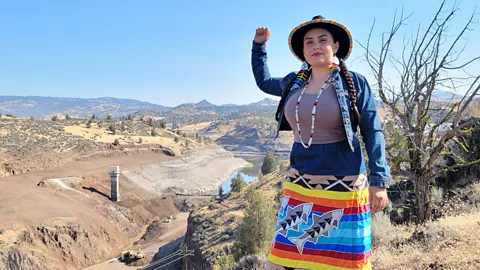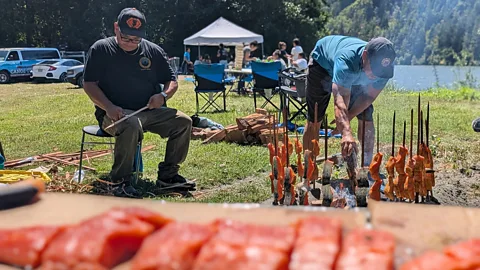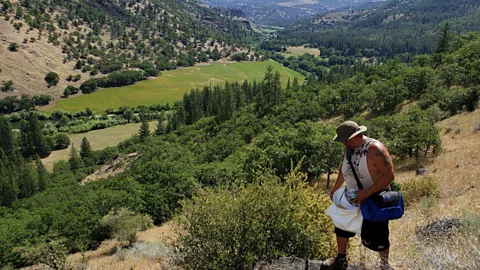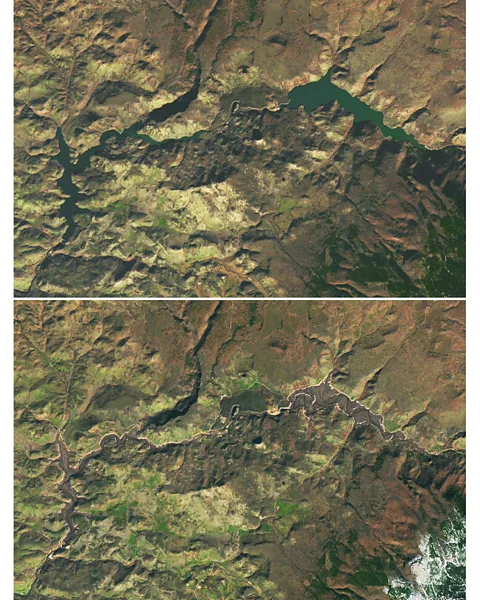 Brook Thompson
Brook ThompsonThe Klamath River is free of four huge dams for the first time in generations. But for the Yurok tribe, the river’s restoration is only just beginning – starting with 18 billion seeds.
Brook Thompson has been fishing on the Klamath River ever since she could stand up in a boat. To Thompson and her family, who are part of the Karuk and Yurok tribes from northern California, fishing is second nature. “The river was our grocery store,” the 28-year-old explains. That was until a catastrophic fish die off happened in 2002.
“It changed everything,” Thompson remembers. “We’d always had plenty of food up until then. As a seven-year-old, the salmon were almost as big as me, and I saw thousands of their bodies piled up on the shoreline, I smelled their rotting flesh. It was apocalyptic.”
The Yurok Reservation sits on the final 44 miles (71km) of the Klamath River before it meets the Pacific Ocean – a remote strip of land where there is one convenience store attached to the local gas station. Pre-contact, their territory spanned more than one million acres (400,000 hectares). The tribe relies on the river and the land for sustenance. And in the oral history of the Yurok tribe, which extends back thousands of years, there was no record of anything like this ever happening before.
“Since time immemorial, nothing like this had ever happened to us. A whole generation of salmon died on that one day,” says Thompson. Low water flow from the Iron Gate Dam, one of four on the lower Klamath River, was found to be a “substantial causative factor”, a report from the Yurok Tribal Fisheries Program found.
A decades-long fight
The dams have long been a point of contention for the tribe, who have been campaigning for their removal since the 1990s. The river is the lifeblood for the Yuroks, and the salmon are family. “The death of salmon means the death of our entire way,” Thompson says. “Everyone is connected. Taking these dams down is a life-or-death situation for us.”
Finally, at the end of August 2024, after years of negotiating, and decades of activism, the last dam fell, reopening more than 400 miles (644km) of river, in what is the largest dam removal project in US history.
 Lucy Sherriff
Lucy Sherriff“This is decades and decades in the making,” says Thompson. “We were told it was never going to happen. That it was foolish to even ask for one removal. We were asking for four.”
The Klamath Basin covers more than 12,000 square miles (31,000 sq km) in southern Oregon and northern California, and was home to the JC Boyle, Copco 1, Copco 2 and Iron Gate dams, all owned by PacifiCorp, an electric utilities company. The Klamath was once the third-largest salmon producing river on the US’s West Coast before the construction of the dams blocked fish from accessing almost 400 miles (640km) of critical river habitat for almost 100 years.
Fall chinook salmon numbers plummeted by more than 90% and spring chinook by 98%. Steelhead trout, coho salmon and Pacific lamprey numbers also saw drastic declines, and the Klamath tribes in the upper basin have been without their salmon fishery for a century, since the completion of Copco 1 in 1922. The situation became so bad that Yurok tribe – who are known as the salmon people – began importing Alaskan salmon for their annual salmon festival, traditionally held to celebrate the first return of fall chinook salmon to the Klamath River.
“It was painful,” says Willard Carlson, a Yurok elder who is known as a river warrior and was part of the inter-generational campaign. “All those years seeing our river damaged like that. I remember as a kid we’d have other people from nearby tribes making fun of our river. ‘Oh, you’re Yurok, your river is dirty.’ For us, the dams were a monument to the [coloniser] people who conquered us.”
 Lucy Sherriff
Lucy SherriffRemoving the dams has been a rocky road, thanks to the number of tribal, local, state and federal stakeholders, and the cost of removal – estimated at $450m (£340m).
“The removal is a victory,” says Carlson, although he isn’t fully celebrating yet. “We’re still having to be cautious, because our resources are still under threat.”
The water that initially rushed downriver was dirty and smelly, say the tribe, and debris that had piled up behind the dams for decades suddenly was dislodged and brought downstream. But even in the few months since the first dam was removed, they’ve noticed a difference.
“A couple years down the road, once the river has been able to repair itself, we’ll begin to see healthier fish runs,” says Oscar Gensaw, a Yurok tribal member and fisherman. “You can definitely see already the river is starting to do its own thing, and that’s the best thing for us – letting the river do what it needs to do, because it knows what it needs to do to repair itself.
By 2061, it is estimated that the chinook salmon population will have recovered by an average of 81%.
Restoring the land
But something that does need a helping hand is the restoration of 2,200 acres (890ha) of land that is above ground for the first time in a century following the emptying of four reservoirs.
“Removing the dams is one thing, restoring the land is quite another,” says Thompson, a civil engineer and part of the crew working on the restoration project – which is being managed by Resource Environmental Solutions, an ecological restoration company.
 RES
RESPreliminary planning started back in 2011, and in 2020, the reservoir action management plan, a detailed 260-page document was published by the Klamath River Renewal Corporation – the non-profit entity formed to manage the entire dam removal project. ”The document gave us our targets, and has kept us on track,” says Joshua Chenoweth, senior ripariani ecologist for the tribe who was hired to manage the revegetation project.
Between 2018 and 2021 seed collection crews – many of whom are tribal elders – were hired to harvest native seeds, by hand, in preparation for the dam removal. They collected 98 species and around 2,000lbs (900kg) of seeds. The seeds were then dispatched to specialised nurseries, which propagated them en masse, and sent the seedlings to storage facilities where they were kept until the time came for them to be planted.
A total of 18 billion native seeds were propagated – more than 66,000lbs (30,000kg) worth – each species selected for a purpose: to retain sediment, to prepare the soil for other plants, for cultural uses, or to be a food source. Wheatgrass, yarrow, lupine and oak trees – an important cultural species for the Yuroks and a keystone species – to name a few.
“It was an extremely complicated process,” says Chenoweth. “Everything we introduced had to be genetically appropriate, sourced from nearby watersheds. It’s quite a process to work out what species you need, how many seeds you need, and how long you need to grow them for to get the seeds you need.”
The team also had to take into account what species could be found in enough numbers, whether there were nurseries who knew how to propagate them, and which plants would grow quickly enough.
“A lot goes into species selection,” says Chenoweth. “And we had a lot of limits. It’s definitely been a very challenging project, and we were lucky that there were delays in dam removal.” But in the end, the timing worked out. “We didn’t have enough seed until this year, when it was time for the last dam to be removed.”
Seeds from trees and shrubs were also collected, which was a challenge during 2021 and 2022, particularly hot and dry years that exacerbated widespread wildfires, Chenoweth says. “The collection was hard, there was just not much out there. Physically, it was really hard for the crew too – smoky because of the fires, and very hot.” Eventually, the team got the numbers they needed right before the removal – including 1,500lbs (680kg) of acorns.

The most important part about restoration is ensuring a high diversity, says Chenoweth, who had previously worked on the Elwha River dam restoration, which was demolished in 2014. “Most restoration projects are lucky to have six to eight species. We have as many as 22 species in our seed mixes.”
When it came to planting the seeds, Chenoweth has used a variety of methods, including seeding by helicopter alongside the old-fashioned way, by hand. Beginning straight after the first draining in late 2023, the team hand-sowed 500 acres of land, including 25,000 acorns. “It really is the most effective restoration tool. And the only reason we used a helicopter was when muddy conditions made it too dangerous for us to walk on the land.”
The results were “excellent”, Chenoweth says. “Despite a hot and dry summer, where we’ve seeded is green, we’re seeing flowering plants teeming with life. I counted eight different butterflies in the areas we hand-seeded. There’s moths, hoverflies, bees, birds. It’s been a really exciting first year.” The team will continue to seed and plant the area for another two years, prioritising the tributaries important for salmon habitat.
“The first year has definitely given me a lot of hope,” Chenoweth, “but it’ll probably get more challenging from here. Now we’re completely at the mercy of Mother Nature.”
After planting is completed, the area will be monitored and maintained for five years by Resource Environmental Solutions. There are four success criteria set out by the restoration plan that need to be met in order for the project to be considered successful: species richness, vegetation cover, scarcity of invasive species and stem count – applicable for forest areas.
For Thompson, it’s a moment that she has been waiting for almost her entire life. “I saw how nasty the river water was behind those dams – it was this neon, snot-nosed green – and now the water is already running clear,” says Thompson. “Seeing this transformation just within these last few months has been amazing. Growing up, the dams were these huge, immovable objects, 100ft [30m] tall. It all felt so impossible. But anything that can be built can be taken down, right? And watching it happen in real time, I just thought, ‘Wow, it was really this easy to remove them this entire time.'”
Being involved in the restoration has been healing for the tribe, too, and sends a powerful message. “For so long we’ve been forcibly kept off our land, and it’s really powerful to me that we’ve been able to participate,” Thompson says. “It’s so important that this is indigenous-led because usually you see three, five, 10-year timelines when it comes to restoration. When it comes to indigenous mindsets, it’s a seven-generation plan. How is this plant going to affect us 100 years from now? Taking care of a plant that your great-grandmother took care of puts a lot of perspective into life. And this is the first step in reclaiming our ability to take care of the Klamath River.”
But Thompson isn’t hoping to return to the past – she’s looking firmly to the future.
“There’s almost a bit of a fallacy in thinking like it will be returned to what it used to be,” Thompson says. “But I think with traditional ecological knowledge, tribal-led initiatives and current academic understanding of the landscape so you can almost make it better.”
Read More: ‘Anything that can be built can be taken down’: The largest dam removal in US history is


